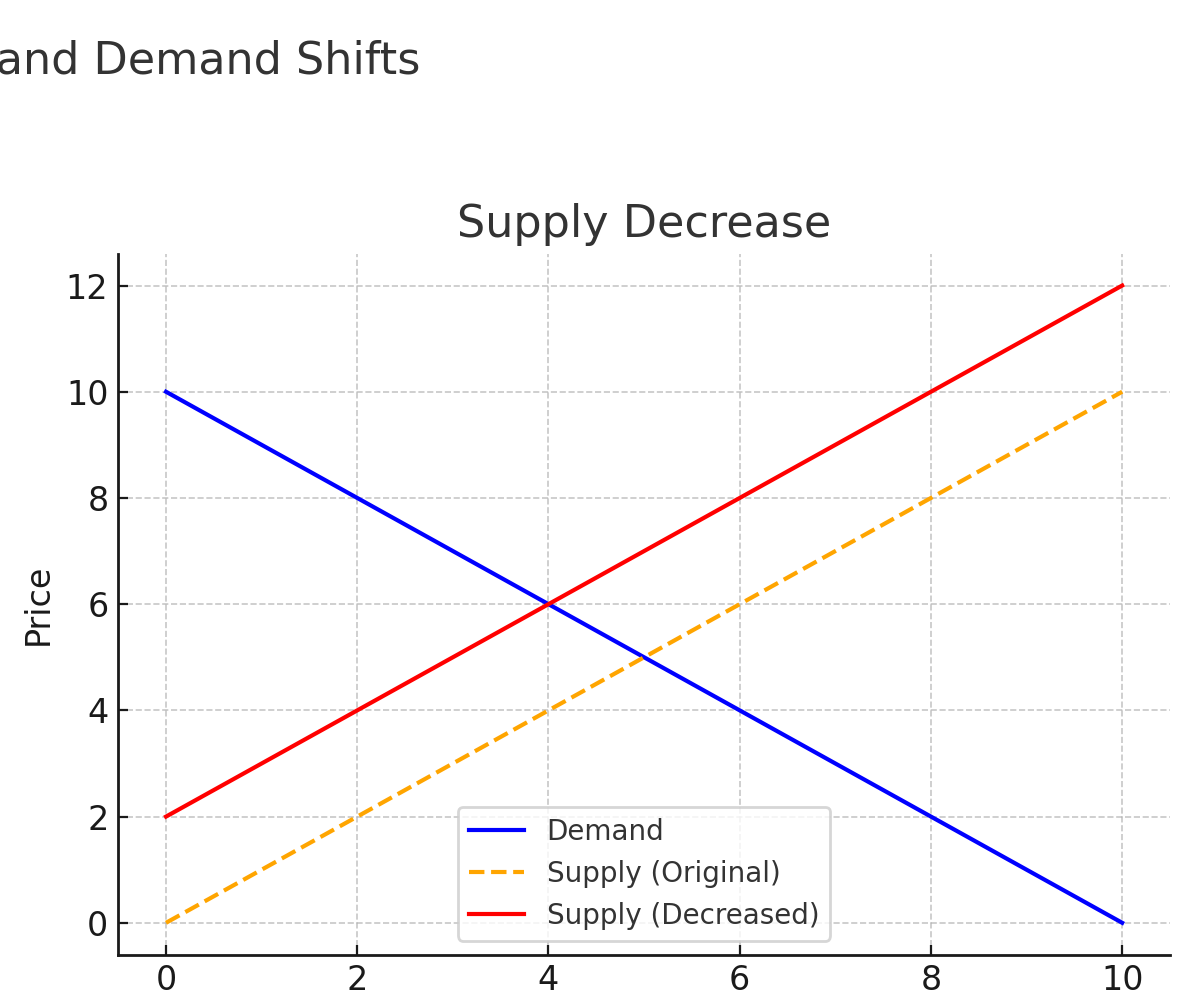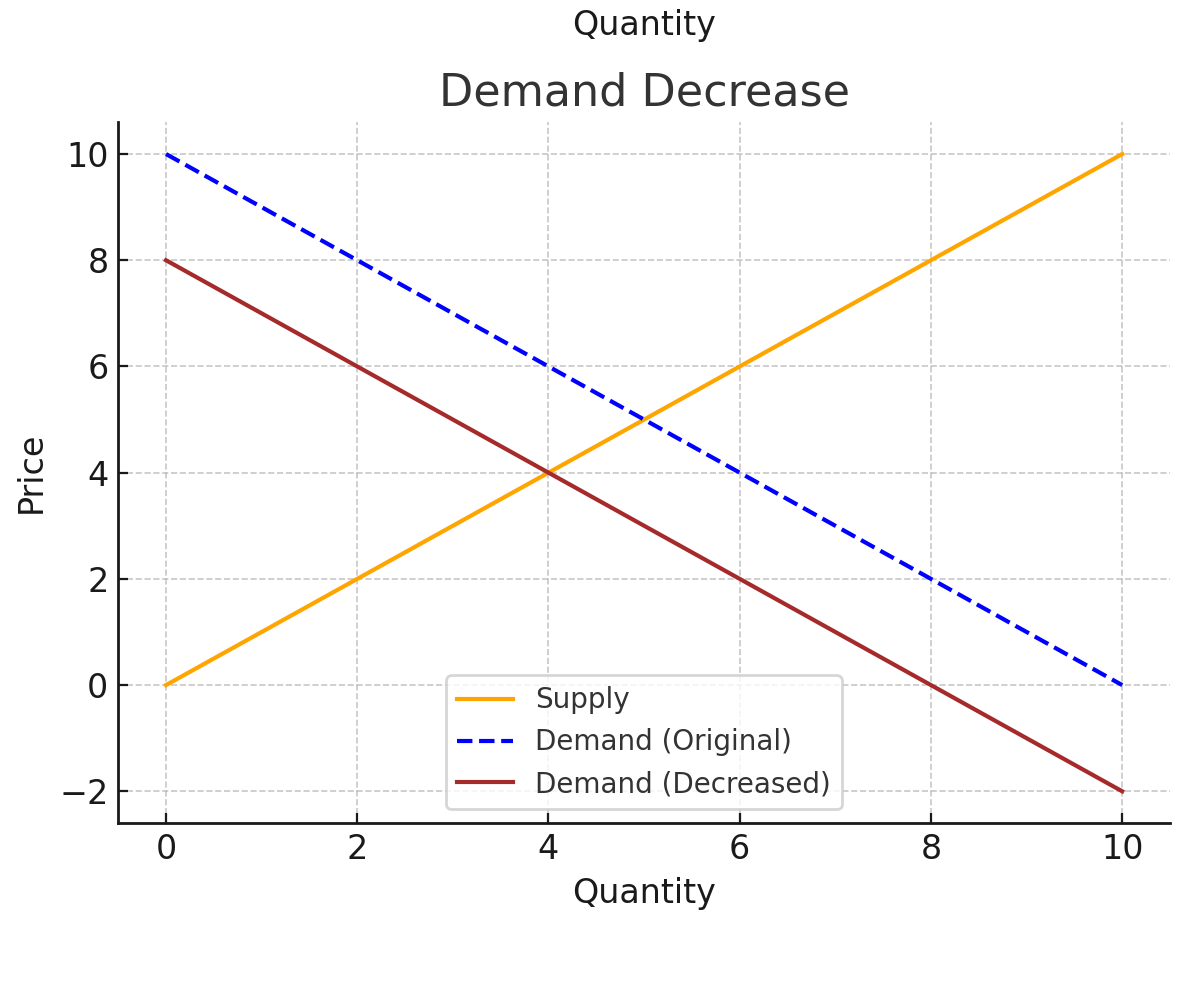micro unit 2 (Demand and Supply)
1/39
There's no tags or description
Looks like no tags are added yet.
Name | Mastery | Learn | Test | Matching | Spaced |
|---|
No study sessions yet.
40 Terms
What is demand?
quantity of a good or service that consumers are willing and able to purchase at various prices during a given period of time
What is the law of demand?
States that there is an inverse relationship between price and quantity demanded. As the price of a good increases, the quantity demanded decreases, and vice versa.
What are the 3 reasons that makes the point on the line demand curve/line move? (demand quantity increases and decreases) SIL. SNACKS IN LUNCH. Hint: change in good itself, never outside factors
substitution effect.
Income effect.
Law of Diminishing Marginal Utility
3 reasons: SIL. Snacks in lunch.
S-substitution effect.
I-Income effect.
L- Law of Diminishing Marginal Utility
What is the substitution effect in SIL (Snacks in Lunch)
When a good gets more expensive, people buy a cheaper alternative instead, so they buy less of the expensive one (substitute) ( which leads to less demand) + vise versa (good less expensive, more demand)
(ONLY caused by a change in the good itself, not its substitute)
ex. if apple’s price increases the demand will decrease as people will go buy oranges, a sub.
What is income effect in SIL (Snacks in lunch)
Caused only by a change in the price of the good itself. (Consumers reaction to prices)
As the price of a good decreases, consumers feel richer and may purchase more of that good, increasing its quantity demanded. (& vise versa: prices high, consumers feel poor, quantity demanded lower)
What is Diminishing Marginal Utility in SIL (Snacks in lunch)
decrease in satisfaction a consumer receives from each additional unit of a good consumed.
ex. As u consume more snacks(froot looms), the additional enjoyment from each additional snack tends to decline, leading to lower price (and demand) at higher quantities.
What are the 5 reasons that makes the demand curve/line itself move? PPIEN (Pretty Princesses In Evil Nigeria). Hint: change outside factors, never good itself
Price of Related Goods
Preferences.
Income
Expectations
Number of consumers
PPIEN. Pretty Princesses In Evil Nigeria.
P- Price of Related Goods (Substitutes&Complements.)
P-Preferences.
I-Income.
E-Expectations.
N- Number of consumers.
What is P (Price of Related Goods ) in PPIEN (Pretty Princesses In Evil Nigeria)
refers to the impact of the price changes of substitutes and complements on the demand for a particular good.
Substitute- If the price of a substitute rises, the demand for the original good may increase (& vise versa (sub price decreases, original good demand decreases)
(ex. price of oranges increased so people will buy more apples (original good), so the demand of apples will go up)
(ONLY caused by a change of substitute, not the good itself)
Complements- goods that are consumed together, so a increase in the price of one can lead to a decrease in the demand for the other. (& vise versa, (less price, more demand))
(ex. ice cream cones increase so ice cream will become more expensive and its demand will decrease.)
What is P (Preferences) in PPIEN (Pretty Princesses In Evil Nigeria)
Preferences refer to the individual likes and dislikes that influence a consumer's choices and demand for goods.
Changes in consumer preferences can lead to shifts in the demand curve for certain products.
(ex. A change in taste or popularity. A study comes out that eating cereal makes u bald so the demand curve would have a lower price and less quantity (moves to the left) & vise versa (higher price more quantity, moves right)
What is I (Income) in PPIEN (Pretty Princesses In Evil Nigeria)
A person’s income determines the quantity of goods they can purchase. If income increases, demand for normal goods rises, while demand for inferior goods may fall.
Normal Goods:
Normal goods are things people buy more of when their income increases, and less of when their income decreases.
(ex. Steak, new clothes, electronics — if you get a raise, you’ll probably buy more of these.)
→ Income ↑ → Demand shifts right
→ Income ↓ → Demand shifts left
Inferior Goods:
Inferior goods are things people buy less of when their income increases, and more of when their income decreases.
(ex. Instant noodles, bus rides, thrift store clothes — if you get richer, you’ll likely switch to something better.)
→ Income ↑ → Demand shifts left
→ Income ↓ → Demand shifts right
ex. if income goes up the demand for designer clothes increases, whereas the demand for lower-quality, less expensive goods decreases.
What is E (Expectations) in PPIEN (Pretty Princesses In Evil Nigeria)
Expectations refer to what consumers think will happen to prices in the future.
If people expect prices to go up later, they’ll buy more now → demand curve shifts right.
If people expect prices to go down later, they’ll wait to buy → demand curve shifts left.
(ex. If gas prices are expected to rise next week, people will fill up now → higher demand now → shift right.)
What is N (Number of consumer) in PPIEN (Pretty Princesses In Evil Nigeria)
This refers to how many buyers are in the market for a good or service.
If the number of consumers increases, more people are buying → demand curve shifts right.
If the number of consumers decreases, fewer buyers → demand curve shifts left.
(ex. A town hosts a music festival and 10,000 people visit — local restaurant demand goes up → curve shifts right.)
In which direction does the demand curve go and why?
The demand curve always slopes downward from left to right. This is because of the Law of Demand:
As price decreases, the quantity demanded increases (people are willing to buy more when the price is lower).
As price increases, the quantity demanded decreases (people are less likely to buy when the price is higher).
What is Supply?
The quantity of a good or service that producers are willing and able to sell at various prices during a given period of time.
What is the Law Of Supply?
A direct relationship between price and quantity supplied.
As the price increases, quantity supplied increases, and vice versa.
What are the 5 reasons that make the supply curve move?
ETPT Even Tuffer Princesses Try Nigerians
💥 These are outside factors that shift the whole supply curve (NOT the good’s price itself):
E – Expectations
T – Taxes & Subsidies
P – Price of Resources (Inputs)
T – Technology
N – Number of Producers
What is E (Expectations) in ETPTN “Even Tuffer Princesses Try Nigerians”?
If producers expect prices to rise in the future, they might hold back now → supply decreases (shifts left).
If they expect prices to fall, they’ll sell more now → supply increases (shifts right).
(ex. Gas prices expected to rise → oil producers supply less now → supply shifts left)
What is T (Taxes & Subsidies) in ETPTN “Even Tuffer Princesses Try Nigerians”?
Taxes = extra cost for producers → supply decreases
Subsidies = financial help from gov → supply increases
(ex. A tax on soda = less soda supply. A farming subsidy = more crops)
What is P (Price of Resources) in ETPTN “Even Tuffer Princesses Try Nigerians”?
If input/resource prices (like materials or labor) go up, it’s more expensive to produce → supply decreases
If they go down, production gets cheaper → supply increases
(ex. Cheaper wheat = more bread can be made)
What is T (Technology) in ETPTN “Even Tuffer Princesses Try Nigerians”?
Better tech makes production faster and cheaper → supply increases
Worse or outdated tech = supply decreases
(ex. A new oven that bakes 50 cookies at once → cookie supply increases)
What is N (Number of Producers) in ETPTN “Even Tuffer Princesses Try Nigerians”?
More producers = more supply → curve shifts right
Fewer producers = less supply → curve shifts left
(ex. New coffee shop opens → coffee supply increases)
What makes the point on the line supply curve move? (Quantity supplied increases or decreases)
Any change to the good’s price itself.
In which direction does the supply curve go and why?
The supply curve slopes upward from left to right.
Because of the Law of Supply:
→ Higher price = more quantity supplied (producers want higher profit)
→ Lower price = less quantity supplied
What is Equilibrium?
The point where quantity demanded equals quantity supplied.
At this price, the market is balanced—no shortage or surplus.
(ex. If 100 people want to buy apples at $1, and 100 apples are for sale at $1, the market is in equilibrium.)
What is Disequilibrium?
A situation where quantity demanded does not equal quantity supplied.
This leads to either a shortage or a surplus.
(ex. If a store has 50 apples but 100 people want them at $1, there's a shortage—disequilibrium.)
What is a Shortage?
Occurs when the price is below equilibrium, causing quantity demanded to exceed quantity supplied.
Buyers want more than what's available.
(ex. Concert tickets priced too low sell out quickly, leaving many fans without tickets.)
What is a Surplus?
Occurs when the price is above equilibrium, causing quantity supplied to exceed quantity demanded.
Sellers have more product than buyers want.
(ex. Unsold holiday decorations after the season ends.)
How does the market correct a Shortage?
Prices tend to rise, encouraging producers to supply more and consumers to buy less, moving toward equilibrium.
(ex. High demand for a new gadget leads to price increases until supply meets demand.)
How does the market correct a Surplus?
Prices tend to fall, encouraging consumers to buy more and producers to supply less, moving toward equilibrium.
(ex. Excess unsold cars lead dealerships to offer discounts.)
Q: What happens to price and quantity when supply increases?
Price decreases, Quantity increases.
Example: A great apple harvest means more apples in stores.
Why: With more supply, sellers lower prices to sell them all, and more people buy at the lower price.

Q: What happens to price and quantity when supply decreases?
📉Price increases, Quantity decreases.
Example: A drought ruins crops, so fewer apples are available.
Why: Scarcity makes apples more expensive, and fewer people can buy at the high price.

Q: What happens to price and quantity when demand increases?
💰 Price increases, Quantity increases.
Example: A famous influencer promotes apples as a superfood.
Why: More people want apples, so prices rise, and sellers produce more to meet demand.

Q: What happens to price and quantity when demand decreases?
Price decreases, Quantity decreases.
Example: A health study says apples cause tooth decay.
Why: Fewer people want apples, so prices drop, and sellers produce less.

Q: What happens when both supply and demand shift at the same time?
A: When both curves shift simultaneously, one of the variables—either price or quantity—becomes indeterminate. This means we can predict the direction of change for one variable, but not both.
Q: If demand increases and supply decreases, what happens?
A: Price will definitely rise because both shifts push it up. Quantity is indeterminate—it could increase, decrease, or stay the same.
Q: If demand decreases and supply increases, what happens?
A: Price will definitely fall because both shifts push it down. Quantity is indeterminate—it could increase, decrease, or stay the same.
Q: If both demand and supply increase, what happens?
A: Quantity will definitely increase because both shifts push it up. Price is indeterminate—it could rise, fall, or stay the same.
Q: If both demand and supply decrease, what happens?
A: Quantity will definitely decrease because both shifts push it down. Price is indeterminate—it could rise, fall, or stay the same.
Q: How do we analyze double shifts?
A: Always draw the supply and demand curves. Identify the direction of each shift and determine which variable (price or quantity) is indeterminate.